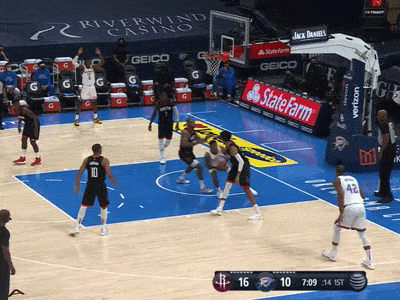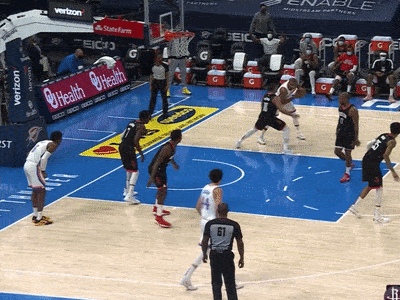Victor Oladipo Stands At A Career Crossroads
Victor Oladipo is a player who will get waived not for playing poorly, but for not making a difference.
Three seasons ago, Vic was a member of the All-Star, All-Defensive, and All-NBA teams. His game was simple: an explosive first step supplemented with a wet pull-up jumper. If defenses hung back to wall off the paint, he splashed 3’s in their face. Step up to take away the shot, and he blasted to the basket.
The current version of Vic is depressing. His broken jumper, lack of bounce, penchant to fumble the ball on drives, poor decision-making, and even worse shot selection make him a negative offensive player. He’s still contributing, but like his former teammate DeMarcus Cousins, he lives in basketball purgatory, a space where he is trapped by expectations of years past.
Echoes of the past
He’s still able to get into the lane, but he doesn’t employ fancy dribble combinations, hesitations, or change of pace moves. It’s just speed. When defenders guard him high on the floor he still has the juice to outrace help defenders to the rim.
But when the help defense does arrive, he doesn’t have the burst or craft to finish over length. He also clanks a fair number of easy layups. That’s okay — the finishing will come around. More concerning though is that he avoids contact on drives. Without free throw attempts, his efficiency lags and he has few opportunities to establish a shooting rhythm.
Adding to this, his inability to knock down outside shots is cramping his off-the-bounce game. Defenders drop back to shut off paths to the rim. To combat this, Vic pulls up for midrange jumpers and decelerates into space to launch fadeaways. The pull-ups aren’t falling, but he has good balance and a soft touch on these one-legged fallaways.
He’s always looking to push in transition. At times, he’s too cavalier, attacking without numbers straight into a forest of limbs for turnovers and bricks. But this constant pressure forms cracks in the defense, especially when he drives to pass. Here he draws three defenders before making the hockey assist.
Vic is not a point guard, but he’s forced into the position when John Wall misses games. His passes are a tad late. He finds teammates for semi-open looks when they were wide-open a moment before. Off the dribble, he gets tunnel vision and jacks contested shots.
This pass to DeMarcus Cousins is indicative of his playmaking. This is a well thrown pass — delivered on-target and in-stride. But it doesn’t create or exploit a strategic advantage. Cousins can’t catch and go up for a shot right away, and the next pass for him is difficult — tossed back across his body. The great pass here would have been to the far side corner, thrown just as Cousin enters the lane to occupy the paint defender.
Defending with gusto and little else
Vic provides extensive value as an on-ball defender. If he scores, he ratchets up the intensity on the following defensive possession. Isolations become personal challenges. Navigating screens is a dance and he’s always a step ahead. His blend of lateral quickness, long arms, and strength make him a tough player to go around or go through. Here he is nimble enough to cut off the initial drive and the change of direction, and strong enough to rip the ball out.
Vic is a chronic ball-watcher. This helps make him one of the best charge drawers in the league. He follows the ball the whole possession so he’s able to bolt into position when the attacker makes their move. Here, he eats LaMelo’s shoulder in transition. He doesn’t even get the call, but the timing and willingness to sacrifice his still-recovering frame is impressive.
Even when he falls asleep on his mark, he has the reaction speed and balance to spring into action and ward off drives. At the start of this clip, Vic is in no-man’s land. When the ball gets kicked out, he turns the wrong way and takes a looping route to the shooter. But somehow he manages to jump in front of the drive even though all his momentum is taking him in the opposite direction.
But of course, ball-watching is problematic. Even with his speed, he can't contest shooters once he's lost their location — a fast driver without a map is still lost. Other times, he falls so far behind the play that he stops defending. Here, he chills in the paint, not helping on the main action nor bothering to recover to his man.
This narcolepsy affects him on the boards too. He’s in no man’s land again watching the ball. When the shot goes up, he doesn’t box out. Instead, he floats under the basket. Not exactly prime real estate for snaring boards. As punishment for his poor positioning, he gets dunked on. He even has the nerve to blame his teammate at the end of the play.
Eat your leafy greens, Victor
Vic shares many of the same frustrating aspects of physical decline as Russell Westbrook. They both lost some of their explosiveness, have suspect shot selection with jumpers that have gone haywire, and make questionable decisions. So many of their struggles are self-imposed. They would be much less damaging to their teams if they laid off the 3 ball.
When Vic was a Pacer, he was quoted as saying, “Down two, shoot three. Every time.” Vic needs to reconsider that mantra. He’s shooting 30% on a career-high 7 attempts per contest. He shoots a healthy 38% off catch-and-shoot jumpers, but he’s canning only 28% of his 3.5 off-the-dribble prayers per game. Transition, pull-up, and stepback 3’s needed to be taken off the menu until he relearns how to cook. You can’t build a shooting rhythm if that’s all you’re eating. But open catch-and-shoot 3’s? Bombs away. He can shoot a 100 a game if they’re created organically off crisp ball movement.
To add value on offense, Vic needs to restructure his dribble-drive game. His priority should be finding open passes, not his own shot. Dribble penetration is the superfood of an offense’s diet. The major benefits are high percentage shots at the rim, open 3’s, and drawn fouls. But it also forces defenses to rotate which creates opportunities for offensive rebounds and Kobe assists — missed shots that beget put-back buckets.
When Father Time comes calling, players can’t play the same way they did when they were younger because they don’t have the same physical tools. They have to adjust. Vic is only 28 years old, but he’s going through that adjustment now. He may return to his previous athletic form, or he might not. Regardless, he needs to add skills that will sustain his game through his next contract and until the end of his career. If he doesn’t, the end may be closer than it appears.










